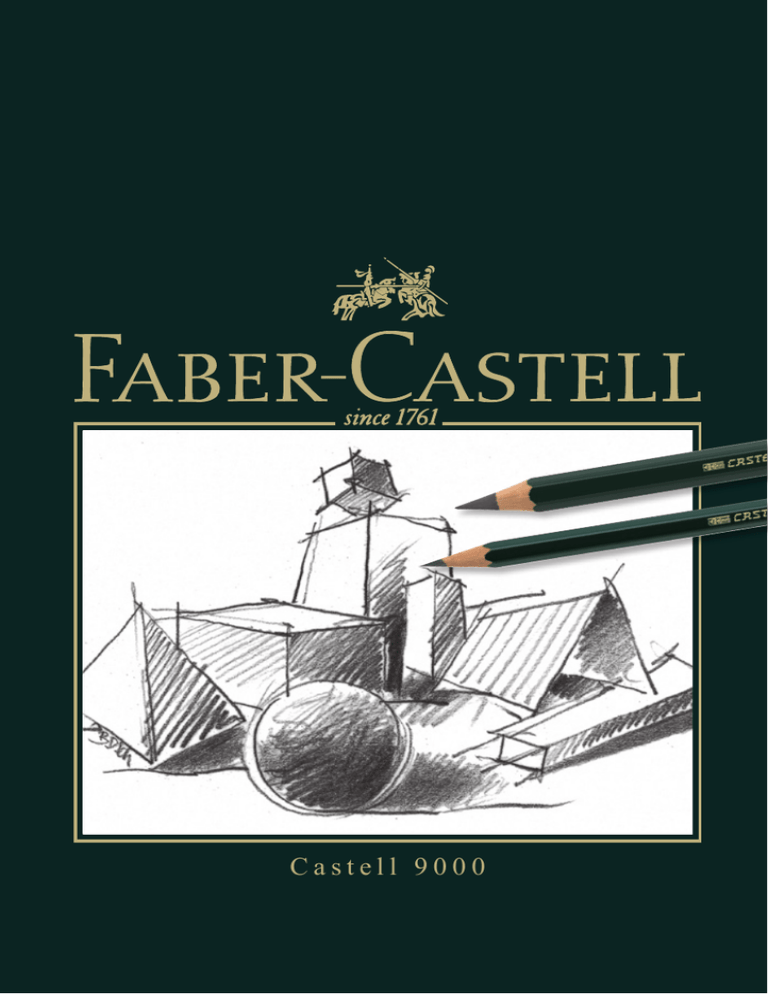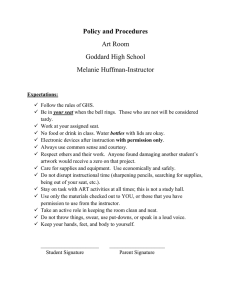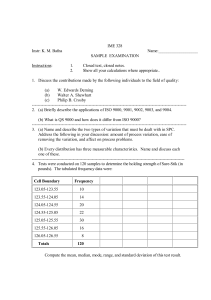Castell 9000 - Faber
advertisement

Castell 9000 ! A new forest project in Colombia secures the livelihoods of small farmers and the wood supply for Faber-Castell – a unique environment protection programme, certified by the UN. With a socially exemplary and sustainable reforestation project in Colombia, Faber-Castell continues to reinforce its leading role as a climate-neutral company. On almost 2,000 hectares of grassland along the Rio Magdalena in Colombia, small farmers are planting tree seedlings for future pencil production. The fast-growing forests not only provide excellent erosion protection for this region plagued by overgrazing and flooding, they are also a reliable source of income for the farmers living in modest circumstances, who are paid for forest maintenance and benefit from the proceeds from the timber. The environmental project was one of the first in the world to be certified for the UN “Clean Development Mechanism” (CDM) programme. This is because Faber-Castell makes an active contribution to climate protection and is one of the first private companies worldwide that is permitted to sell emission certificates from forestry. As the world‘s leading manufacturer of wood-cased pencils, Faber-Castell uses 100% sustainable wood, of which more than 95% is FSC™ certified. Ecological Manager of the Year 2008 (WWF Germany and Capital) Faber-Castell stands for quality Faber-Castell is one of the world‘s leading manufacturers and marketers of quality products for writing, drawing and creative design – the brand name is world-famous. In the core area of woodcased pencils, the group is the most important and oldest manufacturer in the world with a production capacity of more than 2 billion pencils and coloured pencils. Its Art & Graphic range allows Faber-Castell to enjoy a great reputation among artists and hobby painters. Prestigious creative minds have recognised this expertise since time immemorial – from Vincent van Gogh to Karl Lagerfeld. High quality artists‘ pigments ensure light resistance and thus brilliance and colour intensity for decades. All products are based on the same colour system, enabling reliable mixing techniques of artists‘ pencils, whether water-soluble or indelible. Castell 9000 8B For drawings of the utmost ink-like depth •Outstanding quality pencils 6B •For writing, drawing and sketching 5B Very soft and very black 4B Very soft and very black • Wood from sustainably managed forests 3B For a picturesque colour effect and extreme depth 2B Very soft and black •Extra break-resistant lead due to SV bonding B Soft and black •Available in 16 degrees of hardness HB F H Medium soft and medium black For drawing and writing Hard 2H Harder 3H Very hard 4H Extra hard HB = Hard Black 5H Extra extra hard F=Firm 6H The hardest Explanation of degrees of hardness B=Black H = Hard Ideal for writing •Environmentally-friendly water-based varnish Ideal for artistic, pictorial drawing Extra soft and extremely deep black Ideal for technical drawing e.g. for precise plans 7B Green classics Pencil Sharpener •Ergonomic, non-slip GRIP-zone •With safety screw Eraser •Ergonomically-formed eraser with protection sleeve to keep fingers clean •For all popular standard types of pencils •PVC-free high-quality eraser for clean and smudge-free erasing Castell 9000 Design Set •12 pencils Degrees of hardness 5H - 5B Castell 9000 Art Set •12 pencils Degrees of hardness 2H - 8B Castell 9000 Jumbo • Ideal for scribbling, sketching, layouting and drafting • Environmentally-friendly water-based varnish • For professional users like artists, architects, graphic designers, cartoonists and designers as well as hobbyists • Extra break-resistant lead due to SV bonding • The voluminous graphite tip provides a comprehensive range of line widths • High-quality and even graphite laydown • Extra strong lead 5.3 mm diameter • Available in 5 degrees of hardness: HB, 2B, 4B, 6B, 8B Degrees of hardness HB + 2B Medium soft and medium black 4B + 6B Very soft and black For a pictorial tonal impression, great depth 8B Extra soft and deep black For drawings of greatest ink-like impressions of depth Strong companions for drawing Kneadable eraser Ideal for correcting and brightening Paper wiper For smudging and correcting Art Eraser dust-free High-quality plastic eraser for smudge-proof, clean and soft erasing Twin sharpening box Ideal for Castell 9000 Standard and Jumbo pencils, with titanium-­coated sharpening blade for better performance Material + Technique Hold Even the hold influences a drawing. Held at the pencil’s end, the drawing’s character will change to a loose sketch. The further a pencil is held towards its tip, the more specifically and exactly the lines can be drawn. Varying pressure Through varying the applied pressure, the same pencil can produce fine as well as wide lines. Drawing parallel lines while increasing and decreasing pressure is a good exercise for this technique. Surface Choice of paper is of utmost importance for the characteristics of a drawing. The example on the right shows a Castell 9000 Jumbo 8B which has been used on three different types of grained paper. Depending on the grain, the structure of the drawing is fine or coarse. Light and shade In monochrome depictions, colours are represented in tonal values. Different shades of grey convey the pictorial elements’ colour intensity, surface properties and incidence of light. They thus give the picture life and depth. Castell 9000 + Castell 9000 Jumbo Hatching When hatching the lines run in the same direction. Different tonal values are achieved through overlaying and condensing. Line length and distance between the lines further varies the optical result. Cross-hatching When cross-hatching, strokes of the pencil in one direction are drawn on top of strokes made at another angle. Differences in number and density of the overlapping lines create tonal shades. Overhand grip When using the overhand grip, the pencil is held in an extremely flat position in order to create extensive laydown. This technique helps to quickly create large areas and fluid tonal shades. Smudging Loosely applied graphite can be smudged over a specific area with the help of a paper wiper or finger. It is a very appealing technique for creating clouds, water or blurred backgrounds. Gisela Zigawe-Schmitt Born in Trier, Germany Studied at Fachhochschule Saarbrücken (University of Applied Sciences), Germany Degree in Textile Design Freelancer Decoration design for tiles and faïences Illustration Castell 9000 Tip “To emphasise a lighter edge or area, I use an eraser or kneadable eraser for brightening. Highlights on leaves can easily be created using this method.” Gisela Zigawe-Schmitt’s drawings have a rather realistic style, in which lighting plays an important role. Through fine contrasts in the shades of grey she manages to capture the delicate nature of blossoms, leaves or feathers. Sascha-David Salender Born in Schweinfurt, Germany Freelance work in the fields of illustration, design of fun characters, graphic art, tattoo art Currently studying Communication Design at the Faber-Castell Academy in Stein, Germany Product Illustration · Architecture Castell 9000 Tip “I like fine cross-hatching best. It enables me to beautifully present the plasticity of shapes and specifically create contrasts.” Product illustration requires the quick creation of first drafts as well as detailed representations. While loose sketching is supported by the degrees of hardness 4B, 6B and 8B, the degrees HB and 2B provide the wide range needed for a precise and detailed depiction. Sophie Schmid Born in Munich, Germany Studied at Fachhochschule Munich (University of Applied Sciences), Germany Degree in Communication Design Studied at the Academy of Arts in Munich, Germany Degree in Free Painting and Graphic Art Lecturer at various art academies Writer and illustrator of children’s books Children’s Book Illustration “I have been drawing for as long as I have been able to hold a pen. Drawing isn’t an activity for me, but a state of being – one of the best.” Castell 9000 Tip “I draw on white and coloured paper and cardboard and sometimes use white pastel crayons or oil-based pastel crayons. This adds particular depths to the drawings.” Sophie Schmid illustrates and writes children’s books that offer an extraordinary reading and visual experience thanks to their humorous selection of scenes, astonishing variety of technique as well as their distinctive characters. Illustration of Christian Morgenstern’s poem “Der Hecht” (The Pike) Brigitte Doege Born in Munich, Germany Studied Painting and Textile Design at the Academy of Fine Arts in Munich, Germany Freelance work in the fields of painting, colour consulting and design Teaches at the Blocherer School for Communication Design and Interior Decoration in Munich, Hochschule Rosenheim - University of Applied Sciences and the Faber-Castell Academy in Stein, Germany www.doege-design.de Fashion Castell 9000 Jumbo Tip “I prefer the degrees of hardness 6B and 8B because they have a soft stroke and enable sketchy drawing.” “This pencil offers the whole range needed for personal expression – from sketchy, loose play of the hand to modulated lines and dark, heavy areas.” Brigitte Doege prefers the soft versions of the Castell 9000 Jumbo. Her sketchy drawings reflect moments of the artist’s fancy in the depiction which is particularly appealing due to its characteristic liveliness. Raul Miclea Born in Arad, Romania Studied at the Basel School of Design in Switzerland Studied at Georg-Simon-Ohm Fachhochschule Nuremberg (University of Applied Sciences), Germany Degree in Media Design Since 2010 freelance media designer with focus on image design, illustration, photography and video editing www.devnotes.de/ardans Comic Being able to draw a picture about film noir is particularly appealing to Raul Miclea. He wants it to be dark and mysterious. In this scene he is showing a dissimilar couple on the run. Although set in the centre of the city, the other people couldn’t be farther away. Castell 9000 Jumbo Tip “The Castell 9000 Jumbo pencils create all levels of black that are needed to create the necessary tension. Even on relatively smooth paper you get a grain resembling old movies. Underlaying this paper with different structures will transfer it into the picture.” “A film noir plays with perception. That’s why I decided not to add any perspective to the picture. The depth results solely from the staggered arrangement of the various levels, much like in old montages.” Barbara Rogge-Fuchs Born in Nuremberg, Germany Studied at Fachhochschule Saarbrücken (University of Applied Sciences), Germany Degree in Industrial Design Employed in industry and publishing sector, since 1988 freelance work with focus on graphic art, illustration, photography and video www.rogge-fuchs.de Illustration Castell 9000 Jumbo Tip “In order to create a picturesque background, I use a scalpel to scrape some graphite off the lead and onto a piece of paper. I then smudge the loose pigment with a finger or paper wiper.” Every material has its own specific surface look which needs to be captured in the drawing. Graphite pencils are particularly suitable for depicting smooth surfaces like metal, glass or leather. They work exceptionally well for creating fine variations in light, mirroring effects or light reflections. Markus Kronberger Studied Painting and Art in Public Space at the Academy of Fine Arts in Nuremberg, Germany Artistic Assistant and Artistic Director at the Academy of Fine Arts in Nuremberg Head of the Faculty of Fine Arts and lecturer at the Faber-Castell Academy in Stein, Germany Lecturer at various universities · National and international exhibitions www.markus-kronberger.de Painting · Drawing Castell 9000 Jumbo Tip “Drawing is the irreversible condensation of points and lines in a specific area. Consciously applying graphite on paper creates imaginary light and sensual pictorial spaces through light-dark contrasts.” Drawings do not always have to be representational, as exemplified in these works by Markus Kronberger. Space and depth are determined by the distance between, density and characteristics of the corresponding lines. By deliberately reducing the drawing Markus Kronberger orchestrates lighting moods and shades of grey that can only be achieved with a pencil. Markus Klein Born in the Rhineland, Germany Portrait artist Head of Software Development and Design at an IT systems provider www.markus-klein-artwork.de “The challenge is to draw a portrait that is more realistic and alive than a photo. Being able to feel every fibre of the paper when applying the graphite, similar to a needle on a vinyl record, is an incomparable sensory experience in art.” In order for surfaces to gain a more natural texture, Markus Klein uses the HB for extremely fine hatching to resemble the skin’s pores for example. Afterwards, he deepens the shadows and intensifies dark areas with softer pencils. He uses the Pitt Oil-Base extra hard to further carve out microscopic details like eye lashes or the structure of the iris. Castell 9000 Jumbo Tip “The softer degrees of hardness facilitate intense shading, while the HB is ideal for fine hatching and precise details.” A.W. Faber-Castell Vertrieb GmbH Nürnberger Str. 2 · D-90546 Stein / Nuremberg · Germany Phone: +49 911 99 65-0 · Fax: +49 911 99 65-5856 www.Faber-Castell.com · info@Faber-Castell.com


